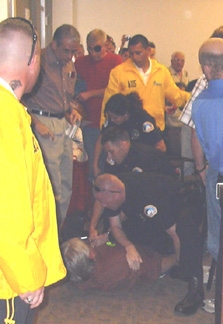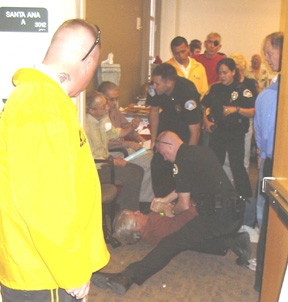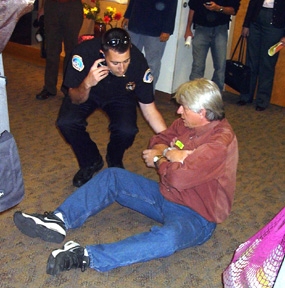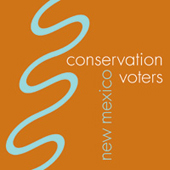Monday, January 29, 2007
Lobbying Day Wed. for Memorial to Dismantle Kirtland Nukes
From Stop the War Machine:
State Senator Jerry Ortiz y Pino's office is writing a memorial that calls for the dismantlement of the 2000 nuclear weapons at Kirtland Air Force Base (the largest concentration of nuclear weapons anywhere -- If Albuquerque were to secede from the union, it would be the world's third largest nuclear power: Russia, USA, Albuquerque). The memorial will be introduced on Wednesday, January 31 (Peace and Justice Day) at the Roundhouse in Santa Fe.
Folks are invited to come to the Roundhouse in Santa Fe on Peace and Justice Day (Wed. Jan. 31) and meet at the Stop the War Machine table (west entrance to the Rotunda) at 10 AM to pick up materials and organize lobby groups. There will be a Press Conference at 11 AM in the Roundhouse Rotunda. All are invited.
All are invited to contact their state senators and state representatives to express support for this memorial.
To find contact information for your state legislator:
https://legis.state.nm.us/lcs/lcsdocs/HouseMailingList.PDF
To find contact information for your state senator:
https://legis.state.nm.us/lcs/lcsdocs/SenateMailingList.PDF
Questions? Contact Jeanne Pahls at 401-4808 or StoptheWarMachine@comcast.net
January 29, 2007 at 06:09 PM in NM Legislature 2007, Nuclear Arms, Power | Permalink | Comments (0)
Tuesday, December 26, 2006
Break the Silence on Plutonium Pit Production!
From Greg Mello, Los Alamos Study Group:
It’s an eerie moment in U.S. nuclear history. Policy teeters on a knife-edge between disarmament an rearmament, but silence largely reigns. The attention of policy-makers, the public, the nonprofit community, and the foundations that largely fund and direct them has not caught up with events, leaving the real policy decisions chiefly in the hands of autonomous, largely unconscious, nuclear bureaucracies.
The National Nuclear Security Administration (NNSA) hopes to begin producing plutonium warhead cores (“pits”) next year at Los Alamos. If that happens, it will be the first time the U.S. has produced pits in 18 years. With new pits, the production of new warheads can also restart, lighting up all ten warhead factories, labs, and NNSA administrative centers with new work and a fresh sense of importance.
Of course these events will echo around the world, reinforcing those who say their nation too should have nuclear weapons. Security will decline for everyone.
Without new pits and the new production that goes with them, the warhead enterprise faces serious internal crises related to an aging workforce, declining practical skills, poor morale, and a fading ideological commitment to nuclear weapons, among other problems. The apparent social consensus that once supported U.S. WMD in the face of bedrock moral values and sound safety, fiscal, and environmental practices has long evaporated.
For at least the next 16 years only Los Alamos can make pits. Yet despite the expenditure of $2.5 billion (B) here so far on pit production numerous problems remain, including serious safety and infrastructure deficiencies. To review some of these problems, look under “LANL” at the Defense Nuclear Facilities Safety Board (DNFSB) web site, www.dnfsb.gov.
The DNFSB has no enforcement powers and relies on NNSA’s voluntary compliance, Congress, and knowledgeable public outcry to keep LANL and other sites safe. Unfortunately NNSA is in the process of implementing a contractor “self-monitoring” system at LANL which is virtually guaranteed, in our view, to produce accidents. One of NNSA’s stated goals is to overcome what it perceives as a “risk-averse” culture in order to “get the job done.”
The situation is grotesque. The U.S. has almost 10,000 nuclear warheads and bombs. Thousands are backups, part of a multi-tiered redundancy that puts the “assured” in “mutual assured destruction.” This is too many even for Mr. Bush, who wants to drop the arsenal to 6,000 by 2012.
Behind the backups and the backups’ backups are extra pits, 13,000 or so of them stored at the Pantex warhead assembly plant near Amarillo.
Pits last a long time. Results of long-awaited accelerated aging studies show that all the pits in the U.S. arsenal have at least six decades of “service” left.
So why make them? Aside from the need to create “end-to-end” work so the enterprise can feed and sustain itself, the other reason for pit production is that even a small production line allows the prompt (“responsive”) production of “boutique” warheads that might be needed for special occasions.
This is not solely a Bush Administration idea. In 1999, when Bill Richardson was Secretary of Energy, LANL gave Congress a detailed briefing on the idea.
As pit production moves toward startup, some $2 B in new LANL plutonium-related facilities is also in the works. The flagship project is a $1 B pit production annex called the “Chemistry and Metallurgy Research Replacement” facility, but several other projects are also involved. NNSA hopes these projects will increase LANL’s pit production capacity enough to build large numbers of new warheads over a multi-decade period, including “small builds of special weapons.”
The CMRR, widely understood to commit NNSA to pit production at LANL indefinitely, is controversial in Congress. The Republican-led House Appropriations Committee wants to kill the project, calling it “irrational” and “stupid.” Republican Pete Domenici promotes it.
What’s eerie is the silence from the arms control community, the Democrats, and the public. Testimony at “Complex 2030” scoping hearings, however heartfelt, is irrelevant to policy decisions – and doubly irrelevant as regards pit production at LANL.
Some arms controllers and Democrats actually want pit production at LANL; others simply don’t know what’s going on. Public debate is led away from these sensitive subjects by powerful foundations, by peer pressure within the nonprofit community, and by career concerns. Most churches fear losing members and contributions.
Practically speaking, the New Mexico congressional delegation holds veto power, should they choose to use it, over pit production at LANL and the new “CMRR” pit factory. They need to hear from us in clear, specific terms: stop pit production before it starts, and cut funding for the CMRR.
[This commentary was written as a guest editorial for a local newspaper.]
Editor's Note: Visit Congress.org for an easy way to contact our congressional delegation.
December 26, 2006 at 09:54 AM in Nuclear Arms, Power | Permalink | Comments (0)
Tuesday, December 05, 2006
REMINDER: Join the Fight Against New Nuke Weapons
From Citizens for Alternatives to Radioactive Dumping:
Stop the nuclear industry's use and abuse of New Mexico! From north to south, New Mexico is being used and abused by the nuclear industry to fulfill its useless and dangerous aims. There are important hearings this week where you can voice your opposition to new nuclear weapons and the participation of Sandia and Los Alamos National Labs in plutonium pit manufacturing and other aspects of the proposed program.
In Albuquerque: Speak Out - Stop the Bombplex
Tuesday, December 5th, 11 AM - 3 PM and 6 - 10 PM
Albuquerque Convention Center
401 2nd St, SW / Cochiti Taos Room
Contact: Shrayas Jatkar, 266-2663, admin@cardnm.org
(Editor's Note: See my earlier post for locations in other parts of NM, as well as more detailed information about what is at stake.)
The Department of Energy (DOE) and National Nuclear Security Administration (NNSA) are rolling through New Mexico this week to push their new plan called Complex 2030. It should really be called Bombplex 2030, because the main idea is to design and produce whole new generations of nuclear weapons.
We can't afford to sit in silence and let Bombplex 2030 get underway. Instead we must raise our voices in opposition and proclaim a vision of a peaceful and sustainable future. Join us Tuesday at the public hearings hosted by the DOE and NNSA at the Albuquerque Convention Center. This is our right to speak out and tell the DOE and NNSA.
If you can't make it to one of the scheduled hearings, you can submit written comments about Complex 30. The Energy Department is also accepting public comments on this proposal. If you are unable to attend the public meetings, you still have an opportunity to share your concerns about the Complex 2030 plans:
Send your comments to the Energy Department by email to: Complex2030@nnsa.doe.gov
Or in writing to:
Theodore A. Wyka, Complex 2030
Department of Energy, NA10.1
1000 Independence Ave., S.W.,
Washington, DC 20585.
***When you send this letter, please make sure to copy your two senators, your representative and local newspapers.***
Top 5 Reasons to Oppose Bombplex 2030...
- It is unnecessary, because the 14,000 plutonium pits (the triggers of a nuclear weapon) stored at the Pantex Plant in Texas are good for a minimum of 90 years; the average age of these pits is just 21 years.
- The U.S. would waste tens of billions of dollars on Complex 2030, which could be better spent on education, health care, and other social needs.
- More radioactive waste would be generated and disposed in New Mexico, threatening people and the environment for thousands of years.
- Los Alamos and Sandia National Labs are essential to Complex 2030 and would therefore continue to produce nuclear weapons. Instead, they should clean up their sites, and become centers of renewable energy research and development.
- By making new nuclear weapons, the U.S. will violate its pledges to nuclear disarmament under the Nuclear Non-Proliferation Treaty. Others will do the same, making the world less safe and secure.
More information on this issue from Physicians for Social Responsibility:
"In the early 1990s PSR played a key role in shutting down the production of nuclear weapons in the United States. The PSR publication Dead Reckoning revealed that tens of thousands of Americans had been killed or made sick with diseases such as cancer because of their work building America's bombs. Health and safety violations were so flagrant that the Rocky Flats plant in Colorado was shut down by the FBI. Now, the Bush Administration has put out a plan, Complex 2030, to get the U.S. back into the nuclear bomb-making business.
The Bush Administration has selected your state as a possible site for a new $5 billion to $10 billion facility to build the next generation of nuclear weapons. Some local leaders in your area are already arguing that this new plant will create jobs and spur economic development. But the U.S. can create jobs without building the next generation of nuclear weapons that would escalate the arms race and pose a greater threat to our planet.
Current and retired nuclear workers have suffered from cancers, beryllium disease and many others conditions. We all suffer psychological harm from living in the shadow of the mushroom cloud. If these dangerous weapons were ever used, it would be the ultimate medical catastrophe. The U.S. government has moral and legal obligations to eliminate its nuclear weapons, not build new ones.
Over the next week, the Energy Department will hold public hearings in your state to discuss plans for this new bomb plant, assess public reaction, and build political support for these proposals. PSR physicians believe this new nuclear weapons plant, a key component of the administration's Complex 2030 plan, is a dangerous step in the wrong direction.
December 5, 2006 at 10:30 AM in Nuclear Arms, Power | Permalink | Comments (0)
Tuesday, November 28, 2006
Attend a Bomplex 2030 Hearing to Stop New Nuclear Arms Race
From Citizen Action NM:
Meet Your Nuclear Neighbor: Sandia National Laboratories. $$$ Why Sandia Loves Bomplex 2030 $$$
What is Bomplex 2030?
The Dept. of Energy/National Nuclear Security Administration has a new plan to re-design and rebuild every nuclear weapon in the U.S. arsenal. This is the so-called “Reliable Replacement Warhead” program -- and the DOE/NNSA proposal to revamp the nuclear weapons complex to produce these new nuclear warheads is called “Bomplex 2030.” The name misleads one to think this plan is for the future. The effect on driving other countries to join the nuclear arms race will be immediate. The social, environmental, and economic costs will be enormous.
WHAT CAN YOU DO??
A Bombplex 2030 Public Hearing will be held by the DOE/NNSA on December 5th at the Albuquerque Convention Center, 11 AM to 3 PM or 6 PM to 10 PM. Attend with Friends in Opposition. Hearings will also be held in Socorro, Los Alamos and Santa Fe. See below for more information.
Hearing Schedule:
- Albuquerque: Dec. 5, Albuquerque Convention Center, 11 AM – 3 PM, 6 – 10 PM
- Socorro: Dec. 4, Macey Center, 801 Leroy Place, 6 – 10 PM
- Los Alamos: Dec. 6, Hilltop House Best Western, 10:30 AM – 2:30 PM
- Santa Fe: Dec. 6, Genoveva Chavez Community Center, 6 - 10 PM
Background Information
Sandia will perform the certification testing for the nuclear triggers called “pits” that will be used in this new line of nuclear weapons. The pit is a nuclear weapon. Sandia will be involved in the design, construction and testing of components for this new line of nuclear weapons. The DOE/NNSA want to quadruple pit production at Los Alamos National Laboratory (LANL) to 80 pits a year. LANL may well become location for a new plutonium center to produce 125 pits a year.
No justification can be found for further production of pits within the weapons complex for the RRW program. 4000 pits exist in “strategic reserve” in addition to a 12,000-plus “surplus” at Pantex in Texas. DOE/NNSA admits that age-induced impacts on pits have not been observed for pits up to 42 years old. The average age of pits in the current stockpile is 21 years old and lifetimes of pits can be 90+ years.
Sandia's primary mission is to implement the nation's nuclear weapon policies through research, development, and testing related to nuclear weapons. Sandia also manages the U.S. nuclear arsenal stockpile. Sandia designs and integrates over 6,300 parts of a modern nuclear weapon's 6,500 components. About 72 percent of Sandia’s $2,200,000,000 ($2.2 billion) annual budget goes for defense and national security related programs. Only a scant 4% of the Sandia budget goes for energy efficiency and renewable energy research.
The words “Reliable Replacement Warhead” are used to mislead the public to believe that the RRW program will maintain the nuclear status quo.
- The current inventory of nearly 10,000 nuclear weapons have been certified as “safe, secure and reliable” annually for the last ten years by the DOE/NNSA
- The National Nuclear Security Administration (NNSA), the weapons arm of the Department of Energy, advertises the RRW as an "enabler" for changing to a "responsive infrastructure" which will one day "provide capabilities, if required, to produce weapons with different or modified military capabilities."
- The official Department of Defense website on "Stockpile Transformation" (the generic name for RRW and related plans) boasts of a goal of "developing warheads for next-generation delivery systems."
Neither the Department of Defense nor the Department of Energy has cleaned up the hazardous waste and radioactive contamination at many locations throughout the United States from the nuclear weapons production during the Cold War. The actions at Los Alamos National Laboratory (LANL) and Sandia National Laboratories (SNL) are part of a larger action of bomb making activities in New Mexico and nationally that devastate water and air resources through release of hazardous and radioactive wastes. In New Mexico, for example:
- Sandia National Laboratories’ (SNL) Mixed Waste Landfill (MWL) is a radioactive cesspool that threatens the drinking water supplies for Albuquerque, New Mexico with 100,000 cu. feet of hazardous and radioactive wastes in unlined trenches. DOE/NNSA has failed to excavate the MWL for long-term protection of Albuquerque’s drinking water. There is no adequate well-monitoring system that complies with federal law. Monitoring wells were constructed using Bentonite clay and organic drilling additives that hide contaminants instead of detecting them.
- Storm water run-off at LANL contains significant amounts of americium-241, strontium-90 and plutonium-238 & 239 measured at levels up to ten times the drinking water standard. Hundreds of other toxic contaminants are in the soil at the bottom of the canyons and contaminated wetlands. Contaminated stormwater either seeps into the ground, posing a threat to groundwater, or, in intense storm events, drains to the Rio Grande.
The Bomplex 2030 program flies in the face of legal requirements for the United States to participate in the Nuclear Non-Proliferation Treaty. Bomplex 2030 will create the capacity for the US to build nuclear weapons more rapidly, reducing the size of nuclear warheads to allow a greater range. The 1970 Non-Proliferation Treaty (NPT) obliged all nuclear weapons states as signatories to Article VI of the Treaty to undertake “to pursue negotiations in good faith on effective measures relating to cessation of the nuclear arms race at an early date and to nuclear disarmament...” International security is further destroyed by the fear that the US will use these weapons of mass destruction “preemptively. A new nuclear arms race must be prevented.
Other countries are no longer deterred by the nuclear threats of the United States but will seek to also obtain nuclear weapons. Nuclear bombs can be built by any country with the will to do so. The secrets for the technology are out. The US must turn from threatening annihilation of other countries to serious participation in solving the global problems of poverty and environmental damage that lead to political unrest, hopelessness and terrorism. The tens of billions planned to be spent by the US weapons complex for new warheads must be spent instead to create more peaceful societies in our world.
THE US NEEDS FRIENDS, NOT MORE BOMBS IN THIS WORLD: These scoping hearings will be your opportunity to tell the Department of Energy (DOE) that your “vision of the future” opposes plans to spend more TENS of BILLIONS OF DOLLARS to build new nuclear weapons in New Mexico. The scoping hearings are required as part of an Environmental Impact Statement. Demand environmental and social costs be considered now!
November 28, 2006 at 12:34 PM in Nuclear Arms, Power | Permalink | Comments (2)
Monday, October 16, 2006
Citizen Action NM to Sue Sandia National Labs on Mixed Waste Landfill Illegalities
From Citizen Action NM:
Citizen Action New Mexico, an Albuquerque-based public interest group, today filed a Notice of Intent to Sue charging that state and federal regulators for the Mixed Waste Landfill (MWL) at Sandia National Laboratories (SNL), allowed the illegal operation of the MWL. This included the failure to enforce the requirement to have federal permits and failure to properly monitor the ground water underneath the dump. The notice names the New Mexico Environment Department (NMED), the U.S. Department of Energy (DOE), the U.S. Environmental Protection Agency (EPA), the Department of Defense (DOD), Sandia National Laboratories (SNL) and Lockheed Martin Corporation.
The Mixed Waste Landfill, a Cold War legacy waste dump containing an estimated 100,000 cubic ft. of radioactive and hazardous waste, is situated on the East Mesa at Sandia National Laboratories, Albuquerque, New Mexico and operated from 1959 to 1988. Citizen Action contends that years of data collected from monitoring wells at the MWL are unreliable and do not justify the NMED’s approval of a permit that will allow DOE/SNL to place a vegetative cover over the dump. Citizen Action maintains that excavation of the dump’s toxic wastes is the only sure way to protect Albuquerque’s drinking water.
The legal notice states that the Mixed Waste Landfill represents an imminent and substantial endangerment to the Albuquerque’s sole source aquifer that underlies the dump’s hazardous and radioactive wastes. The notice alleges that the NMED failed to impose permitting, closure and groundwater monitoring requirements under a federal law known as the Resource Conservation and Recovery Act (RCRA). RCRA requires that hazardous landfill operations either had to have permits to operate legally or the dump should have been closed to provide maximum protection to the public. Citizen Action contends the NMED and EPA failed to take corrective action against DOE/Sandia for known violations and deficiencies at the dump.
The 36-page notice examines the legal permitting history of the Mixed Waste Landfill from over 20,000 pages of administrative records from a public hearing conducted for the dump in December, 2004. The administrative record shows that the dump operated illegally by disposing of hazardous wastes without obtaining a permit required under RCRA. RCRA provides for criminal prosecution where there is knowledge that disposal of hazardous waste is taking place when there is no federal permit.
Legal charges of DOE/Sandia’s criminal wrongdoing involve falsification of records by purging and destruction; violations of manifest and record keeping requirements; the knowing transportation of hazardous waste to an unpermitted dump; and lateral expansion of the dump without providing lined trenches with leachate collection.
Dave McCoy, Director of Citizen Action said, “The NMED has allowed the DOE and Sandia to avoid compliance with strict federal legal regulations designed to protect the community from toxic contamination of drinking water supplies. This has resulted in millions of taxpayer dollars wasted on improper installation of monitoring wells at a legacy waste site. Both the NMED and DOE/SNL have relied on flawed data from the monitoring wells to claim that Albuquerque’s drinking water will remain safe for years to come. However, since the monitoring wells at the dump were installed improperly and are incapable of detecting contamination, there is no accurate information about the status of contamination at the Mixed Waste Landfill to make an informed decision. The safest course of action is to excavate the waste and install proper monitoring wells as required by law.”
McCoy added that similar waste sites have been successfully removed from other locations at Sandia, Los Alamos National Laboratory, Idaho National Laboratory, and other locations without injuring workers or causing dangerous public exposures.
The administrative record puts the EPA and NMED on record in the early 1990s in stating that the well monitoring system at the dump was not in compliance with federal law:
- “The monitoring system is inadequate;”
- “The monitoring wells are located crossgradient instead of downgradient from the MWL; therefore, contaminants emanating from the MWL may not be detected in the monitoring wells;”
- “The hydraulic conductivity of the aquifer is unknown;”
- The mud drilling technology used for several of the wells was “considered to be the worse [sic] drilling technology available.”
Despite the deficient well monitoring, neither the NMED nor the EPA took action to require the monitoring wells to be correctly installed in proper locations to comply with federal law. Instead, the regulators continued to rely on data from the wells which they knew to be spurious.
Citizen Action is a project of the New Mexico Community Foundation and a member of the New Mexicans for Sustainable Energy and Effective Stewardship (NMSEES). Contact: Dave McCoy dave@radfreenm.org
October 16, 2006 at 02:02 PM in Nuclear Arms, Power | Permalink | Comments (0)
Friday, September 29, 2006
Anti-War Leader Arrested in Albuquerque
From Luis Martin, Boletin Latino:

Photo: Luis Martin, Boletin Latino
Albuquerque, 9-29-2006
Bob Anderson, leading anti-war activist for Stop the War Machine (SWM) in Albuquerque, was tackled, handcuffed, dragged and led away to Bernalillo County Detention Center West by University of New Mexico (UNM) police today at approximately 2:00 PM. The incident occurred at a campus meeting sponsored by UNM in which a panel of speakers for think tank Sandia National Laboratories were promoting the building of a new generation of nuclear weapons.
According to one witness, Anderson objected to the exclusion of anti-war views from the makeup of the panel. As someone next to him raised an anti-war placard, one member of the panel asked that it be lowered saying signs were prohibited at the meeting. As campus police entered the room, the panel member pointed to Anderson asking them to remove him from the room. Throughout the entire incident, some bystanders shouted at police to refrain from manhandling the dissenter. No other details are immediately available.
At approximately 5:30 PM, Jean Pahls, Anderson's wife, told Boletin Latino that Bob had been released from detention on his own recognizance.
UNM ranks in the top 15 universities in the country for war profiteering.

Above, Below: Bob Anderson being violently arrested after requesting a fair makeup of a panel sponsored by UNM to promote building nuclear weapons. All photos: Luis Martin, Boletin Latino

Editor's Note: Check out our earlier post about the conference where Anderson was arrested.
September 29, 2006 at 07:34 PM in Local Politics, Nuclear Arms, Power | Permalink | Comments (16)
Monday, September 25, 2006
One-Sided Sandia/UNM Symposium Focuses on Future of U.S. Nuclear Weapons Complex and New Nuclear Bomb Designs
Concerned about the so-called future of nuclear weapons production in New Mexico? Here's info on a symposium that appears to be paid for in large part by Lockheed-Martin, which would benefit greatly from the resumption of weapons production in our state. Concerned citizens are encouraged to attend:
From the UNM OPST:
The University of New Mexico's Office for Policy, Security and Technology presents a symposium, "The Reliable Replacement Warhead Program and the Future of the U.S. Nuclear Weapons Complex," on Friday, Sept. 29, from 1:30 to 4 PM in the UNM Student Union Building Santa Ana rooms A and B. OPST is a joint venture of UNM and Sandia National Laboratories. The program will be preceded by a Women in International Security informational meeting from 12:15-1:15 PM and followed by a reception for speakers and participants.
The symposium features speakers from the National Nuclear Security Administration and Sandia National Laboratories. Confirmed speakers include Susan Stoner, science advisor, defense programs, National Nuclear Security Administration; Bruce C. Walker, director, NM Weapon Systems Engineering Center, Sandia National Laboratories; Linda J. Branstetter, Advanced Concepts Group, Sandia; Celeste Drewien, System Studies Department, Sandia; and Elizabeth A. Stanley, assistant professor, Edmund A. Walsh School of Foreign Service and the Department of Government, Georgetown University.
Andrew L. Ross, director of the Office for Policy, Security, and Technology and UNM political science professor, said he is "delighted to have had the opportunity to work with WIIS and Sandia to develop the program." He is "looking forward to a serious examination of the requirements and plans for the Reliable Replacement Warhead Program and a broad-ranging discussion of its potential implications."
This event is free and open to the public. For additional information, contact Andrew L. Ross, Director, OPST at 505-277-7391 or aross@unm.edu.
***************
According to an Action Alert from the Los Alamos Study Group:
Those of you familiar with our situation in New Mexico know that UNM is very closely associated with the New Mexico’s two nuclear weapons laboratories and with the military and its contractors. In a 2001 ranking of universities’ military contracts by former Study Group associate Darwin BondGraham, UNM ranked #15 nationally in absolute value of its military contracts.
For example, UNM has a $50 million grant from the Defense Threat Reduction Agency (DTRA), the agency sponsoring the proposed 0.6 kiloton Divine Strake explosion meant to help perfect (or far more likely, to demonstrate) a low-yield nuclear earth-penetrating weapon. The head of DTRA at the time of the grant (and of the conception of Divine Strake), was Steve Younger, former head of weapons design at Los Alamos National Laboratory (LANL) and now manager of the Nevada Test Site (NTS) for the Northrup-Grumman led consortium running NTS. I am sure it is no accident that Dr. Younger was able to remember New Mexico and Senator Domenici when he made that huge DTRA grant. (A Sandian and former Reagan Administration official, , now runs DTRA).
This ranking of #15 in military funding, high though it is, does not capture the full scope of UNM’s institutional obeisance to the nuclear-military complex or its role in training new workers for the labs and weapons plants. I want to go into the context of this panel just a little to illustrate how this is apparently working in this case.
OPST was created by former SNL senior vice president and weapons manager Roger Hagengruber, who started up OPST in 2003, bringing with him a 5-year grant from SNL to UNM of $250,000 per year to establish OPST. The current director, Andrew Ross, took over for Hagengruber in 2005.
Besides SNL and OPST, the other panel co-sponsor is WIIS, headquartered at Georgetown University. The funders WIIS mentions are here; its executive board is here.
He who pays the piper calls the tune. In this case Lockheed appears to be paying, and there is nobody on the panel without direct ties to SNL or the National Nuclear Security Administration (NNSA) which funds most of SNL. The one person on the panel who does not work directly for the NNSA or a nuclear lab is Elizabeth Stanley, a member of SNL’s National Security Advisory Board. Let us hope she is enough of a nuclear abolitionist to balance the four others.
OPST does many things, including sponsoring a recent CIA speaker on the anniversary of 9/11/01 and sponsoring curriculum development, including a grant for "The Human Settlement of Space: Practical and Political Pitfalls and Possibilities," to Mohamed S. El-Genk, whose main interest is space nuclear power systems. There is nothing to suggest that entire ambit of OPST’s activities falls anywhere but inside the narrative of national security state, or what might be expected in a sort of “Lockheed-Martin University,” if we had one. Perhaps in a way we do.
The warhead program in question. The RRW is a huge program that aims to remake the entire U.S. nuclear arsenal with new untested warheads, at a cost that would certainly exceed $100 billion dollars between now and 2030 (a date NNSA is using as a milestone these days).
The RRW program, in addition to making thousands of new warheads, is conceived as enabling the creation of a new “responsive infrastructure” of nuclear factories and labs, the mere existence of which is supposed to help “deter” America’s enemies, “dissuade” America’s competitors, yadayada. The pivotal and rate-determining step in this plan is the manufacture of plutonium warhead cores (“pits”) at LANL, which, contrary to statements you may have read, has not yet begun. (Practice manufacturing has begun, but no pits for the stockpile yet.)
I didn’t use the word “genocide” in the title of this action alert lightly. There is no use of nuclear weapons that would not involve mass destruction of human beings and the will to do so. It would not be an unfortunate “accident.” The terror of this in the heart of the enemy puts the “terr” in nuclear deterrence, as former Sandia President Paul Robinson used to say. Nobel Laureates and Manhattan Project veterans Enrico Fermi and Isidor Rabi said it somewhat differently in 1949 in their addendum to a report on the question of whether to develop a hydrogen bomb:
It is clear that the use of such a weapon cannot be justified on any ethical ground which gives a human being a certain individuality and dignity even if he happens to be a resident of an enemy country…It is necessarily an evil thing considered in any light.
This quote and much more useful material can be found in the essay on the cover of the Call for Nuclear Disarmament brochure (pdf).
September 25, 2006 at 10:17 AM in Nuclear Arms, Power | Permalink | Comments (1)



































